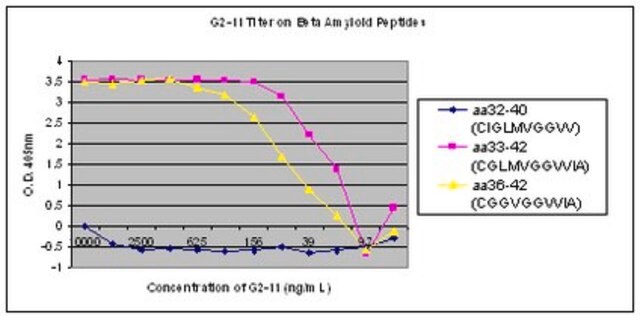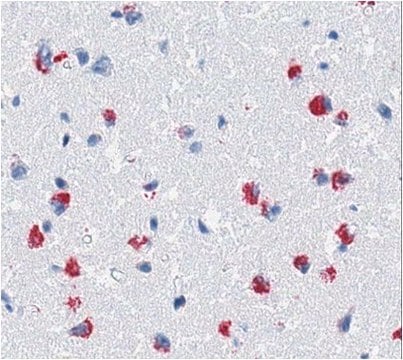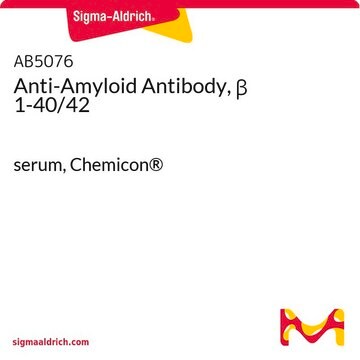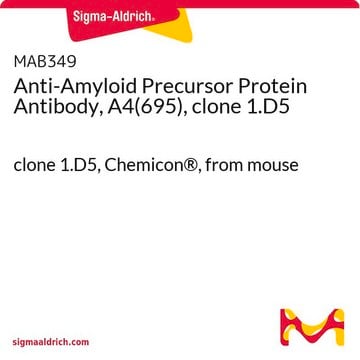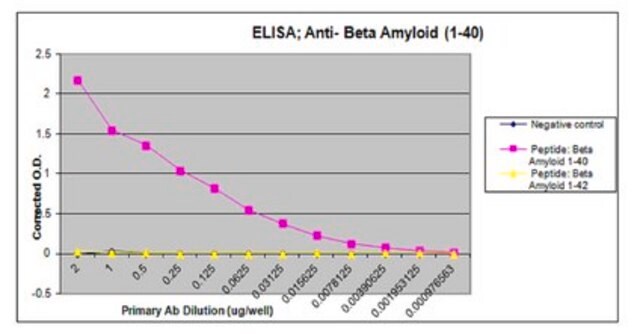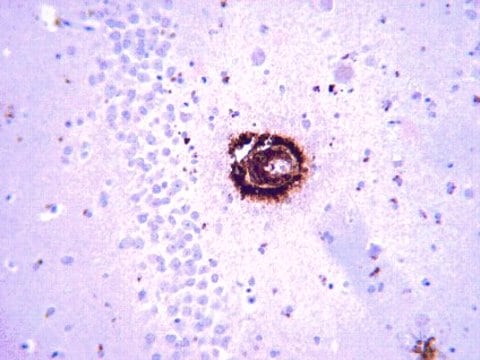MABN254
Anti-amyloid beta peptide (MOAB-2), pan Antibody, clone 6C3
clone 6C3, from mouse
Synonyme(s) :
Amyloid beta A4 protein, ABPP, APPI, APP, Alzheimer′s disease amyloid protein, cerebral vascular amyloid peptide, CVAP, PreA4, Protease nexin-II, PN-II
About This Item
Produits recommandés
Source biologique
mouse
Niveau de qualité
Forme d'anticorps
purified immunoglobulin
Type de produit anticorps
primary antibodies
Clone
6C3, monoclonal
Espèces réactives
human
Technique(s)
dot blot: suitable
immunofluorescence: suitable
immunohistochemistry: suitable (paraffin)
immunoprecipitation (IP): suitable
western blot: suitable
Numéro d'accès NCBI
Numéro d'accès UniProt
Conditions d'expédition
wet ice
Modification post-traductionnelle de la cible
unmodified
Informations sur le gène
human ... APP(351)
Description générale
Spécificité
Immunogène
Application
Western Blot Analysis: A representative lot was used by an independent laboratory in unaggregated forms of Aß42 and Aß40. (Youmans, K.L., et al. (2012). Mol Neurodegener. 7;8.)
Dot Blot Analysis: Serial Aβ40 and Aβ42 dilutions were probed with MOAB-2 or 6E10 by an independent laboratory. (Youmans, K.L., et al. (2012). Mol Neurodegener. 7;8.)
Immunoprecipitationt Analysis: A representative lot was used by an independent laboratory in unaggregated and fibrillar forms of Aß42 and Aß40. (Youmans, K.L., et al. (2012). Mol Neurodegener. 7;8.)
Neuroscience
Neurodegenerative Diseases
Qualité
Immunohistochemistry Analysis: A 1:1,000 dilution of this antibody detected Amyloid Beta Peptide in human Alzheimer′s diseased brain tissue.
Description de la cible
Forme physique
Stockage et stabilité
Remarque sur l'analyse
Alzheimer′s diseased human brain tissue.
Autres remarques
Clause de non-responsabilité
Not finding the right product?
Try our Outil de sélection de produits.
Code de la classe de stockage
12 - Non Combustible Liquids
Classe de danger pour l'eau (WGK)
WGK 1
Point d'éclair (°F)
Not applicable
Point d'éclair (°C)
Not applicable
Certificats d'analyse (COA)
Recherchez un Certificats d'analyse (COA) en saisissant le numéro de lot du produit. Les numéros de lot figurent sur l'étiquette du produit après les mots "Lot" ou "Batch".
Déjà en possession de ce produit ?
Retrouvez la documentation relative aux produits que vous avez récemment achetés dans la Bibliothèque de documents.
Notre équipe de scientifiques dispose d'une expérience dans tous les secteurs de la recherche, notamment en sciences de la vie, science des matériaux, synthèse chimique, chromatographie, analyse et dans de nombreux autres domaines..
Contacter notre Service technique
